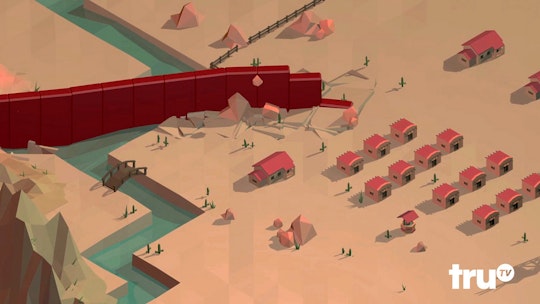
Adam Ruins Everything Adam Conover debunks myths with help from visual effects.
Investigative shows are usually dramas of one sort or another, but truTV’s Adam Ruins Everything is best described as investigative comedy. Hosted by CollegeHumor’s Adam Conover, the half-hour show examines popular misconceptions and trends, debunking some things while offering in-depth explanations of others.
The show’s narrative is supported by distinctive visual effects that run the gamut from funny to heartbreaking. Los Angeles-based Patrick Longstreth became the show’s VFX supervisor once it was picked up after the pilot. Relying primarily on Cinema 4D, Maya and After Effects, he and his team of five artists have so far finished 26 episodes, and they are currently working on 16 more.
Here Patrick explains how the team goes about creating custom effects, animations and graphics packages for each show.
Maxon: How did VFX become such a big part of Adam Ruins Everything?
Patrick Longstreth: The pilot had a lot of visual effects, so that sort of set the standard for the show. Our work starts when Adam and the writers finish the scripts, and then everyone involved in production—directors, producers and department heads—sits down together and goes through each episode page by page. I'm very fortunate to be included from the beginning, and it’s an opportunity to offer solutions and put my own creative spin on things. The process of breaking everything down with the directors has led to more opportunities for VFX that complement the story. We talk about things like the best way to make Adam magically emerge from a toilet, or whether it’s better to have a building explode or implode.
Maxon: What’s your pre-visualization process?
Longstreth: For scenes where we do a heavy amount of VFX, I start early by storyboarding and pre-visualizing an animatic. I use Cinema 4D for that and what I create can be pretty awkward and goofy, but it works. For example, in the episode where Adam explains voting, the set is meant to look like CNN election night. We built a rough version in Cinema 4D, and then the director and an actor read through the script.

Maxon: What are some of the more advanced animations or effects you’ve done for the show?
Longstreth: I really like what we did for Adam Ruins Shopping Malls. He talks about how malls got started and exposes misconceptions about nutritional supplements, eyeglasses and outlet stores. For the final mall implosion, Adam says “Malls are dying!” and the mall starts to collapse in the background. We filmed Adam and Emily with a green screen behind them, and we projected footage of the actual mall onto fractured geometry in Cinema 4D. The new Voronoi Fracture tool was used to create random cracks and separations, which was so much better than doing it manually.
Maxon: How did you create the scene with the oversized vitamin supplements for the mall episode?
Longstreth: That’s where Adam is talking about health stores and unregulated supplements. He holds up a large pill, opens it up, and pulls a whole variety of wacky things out of it. The pill in Adam’s hand was practical, so the CG pills had to match the shape, color and lighting. To make the pills match the movement of Adam and his guest, we used dynamics in Cinema 4D. The pills have rigid body tags and we animated collider objects to push the pills around.
Maxon: Describe how you make the show’s infographics? It seems like there are a lot of them?
Longstreth: The show does have a lot of infographics. Adam likes to back up all of his theories and explanations with stats and sources, so we’re often superimposing big numbers and graphs over footage or creating full-screen infographics. We did an infographic for Adam Ruins Football about brain injuries.
The animation represents how a helmet protects the skull, but the brain still moves around inside the skull. We took a stock 3D model of a football player and combined it with a rigged skeleton in Cinema 4D. When the football players collide, we used the jiggle deformer to make the brain shake and wobble. To create the final X-ray look we used the default lighting in Cinema 4D and then inverted it in After Effects.


Maxon: Are you exploring any new ways to create VFX for the new season?
Longstreth: Yes. Absolutely. The writers and directors are always pushing us into uncharted territory. So far, we’ve had discussions about a doppelganger Adam, paintings exploding into money and a parody weight-loss competition reality show.
I used to get freaked out when they would come to me with a wild idea, but now we’ve grown to a point where I feel like we can create just about anything. Our VFX team has a broad range of skills from 2D animation and design to 3D effects and compositing. Each one of them has a great attitude and loves a challenge.
We’re also supported by stellar people in the art department, camera, editing and everywhere else. It’s a really fun place to work and I’m extremely grateful for everyone I’ve had the opportunity to meet and collaborate with. One day we’re making a building explode and the next we’re flying through cyberspace. It’s basically my dream job.




